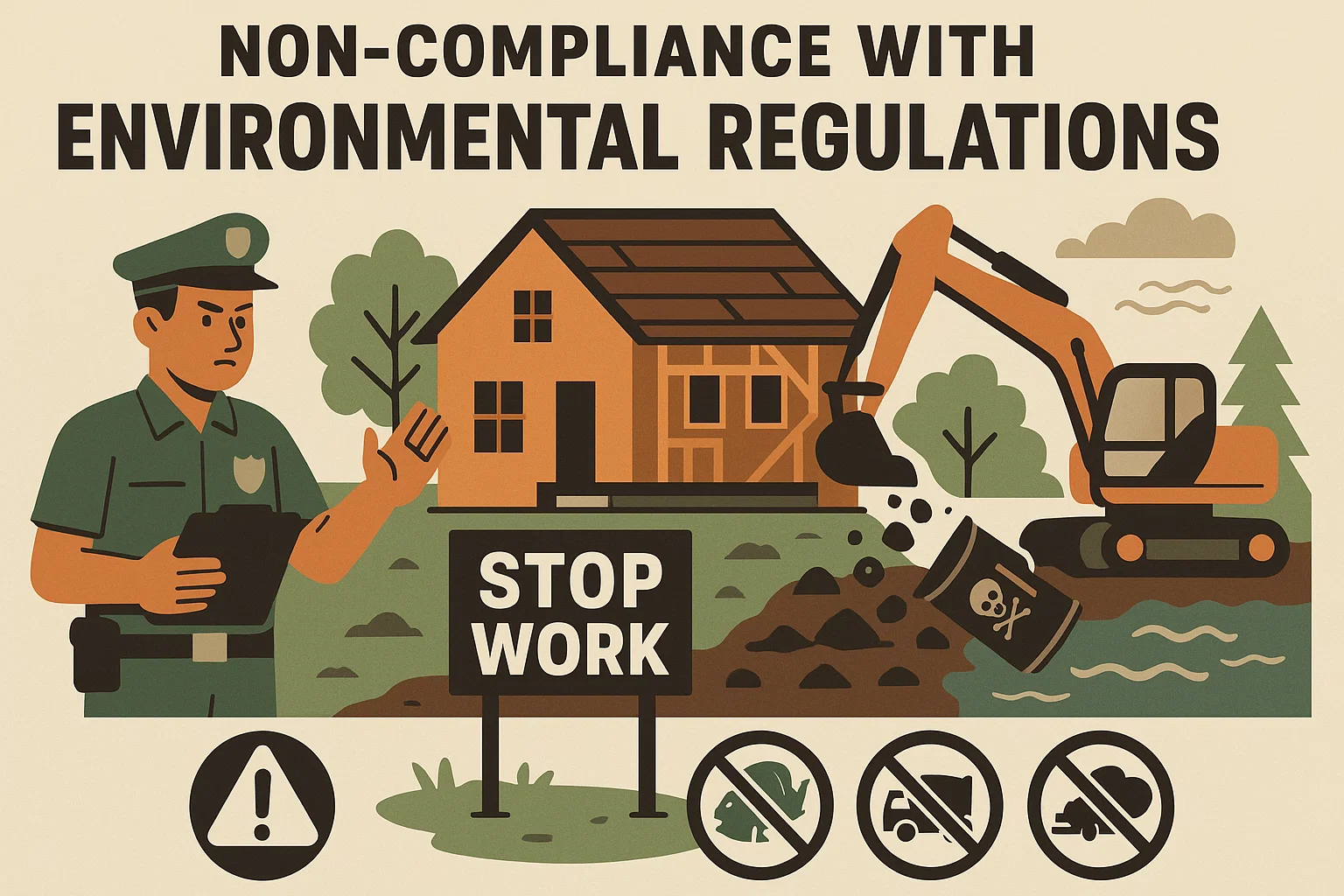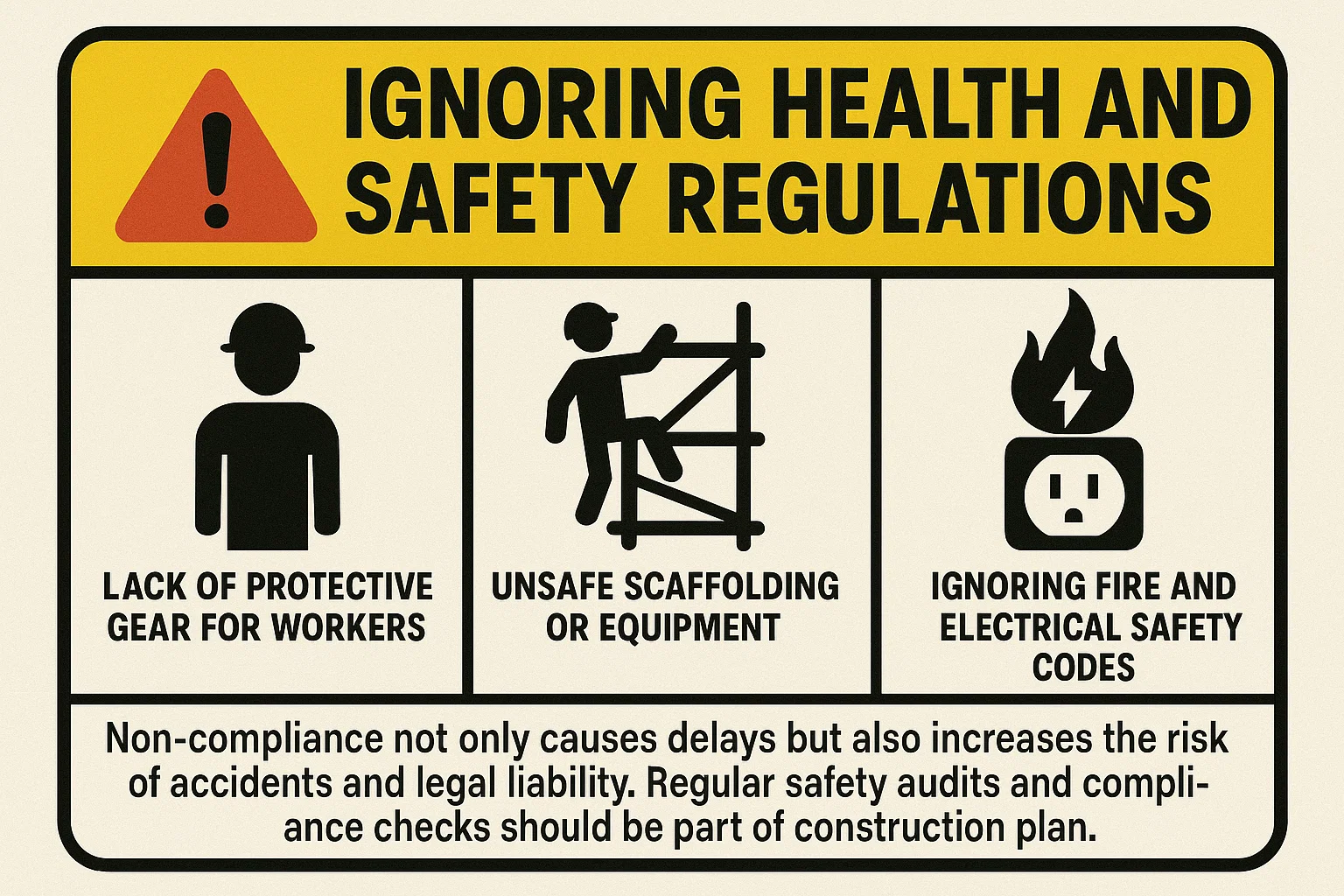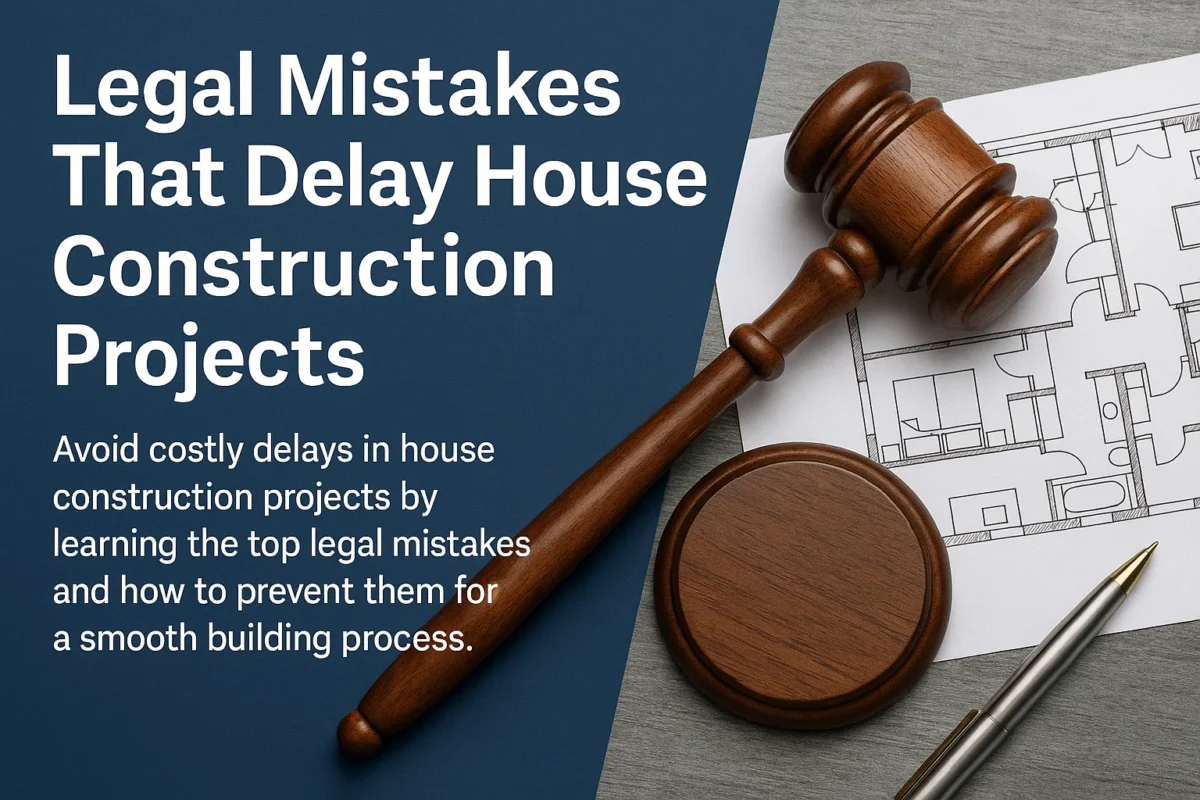Construction, Real Estate
10 Worst Legal Mistakes That Delay House Construction Projects
House construction projects represent a significant milestone for families and investors who are eager to create a lasting space of comfort and value. Yet, behind the excitement and careful planning, many projects encounter frustrating setbacks that could have been avoided. These setbacks are not always due to poor workmanship or lack of resources but often arise from simple legal oversights that spiral into long delays. When critical steps such as obtaining permits, reviewing contracts, or complying with regulations are ignored, the entire construction timeline can collapse, leading to wasted money, strained relationships, and unfulfilled expectations.
A construction project thrives on both technical precision and legal compliance. While architects and engineers ensure that the structure stands strong, legal procedures create the foundation for smooth execution without interruptions from authorities or disputes between stakeholders. Unfortunately, many homeowners discover too late that overlooking these legal details can halt progress for weeks or even months. By understanding the most common mistakes and addressing them early, we can protect our projects from unnecessary delays and bring the dream of homeownership closer to reality.
1. Failing to Secure Proper Building Permits
One of the most common yet costly errors in house construction projects is failing to obtain the required building permits before starting work. Building permits are not just paperwork for compliance; they serve as official authorization that your project meets safety standards, zoning regulations, and structural requirements set by local authorities. When these permits are overlooked or rushed through without careful attention, the consequences can be severe and immediate.
Construction inspectors have the authority to stop work on a site if permits are missing or incomplete. This stoppage often occurs when the project is already underway, meaning that labor, materials, and time have already been invested with no progress moving forward. Restarting after such a halt usually involves paying fines, resubmitting applications, and waiting for new approvals, all of which increase costs and push back timelines. These delays can extend for weeks or even months, depending on how quickly the errors are corrected.
Another risk of working without proper permits is the possibility of being forced to redo parts of the project that do not comply with building codes. For example, if a foundation is poured or a roof is installed without approval, local authorities may require demolition and reconstruction to meet standards. This not only wastes money but also places additional stress on both the contractor and the homeowner.
To avoid these pitfalls, homeowners should work with contractors who have experience in the local permitting process. A reliable builder understands the importance of securing approvals for structural work, electrical systems, plumbing, and other regulated elements of construction. It is equally important for homeowners to personally verify that all permits are in place before giving approval to begin work. Proper documentation ensures that the project runs smoothly from the start, prevents unwanted legal trouble, and provides peace of mind knowing the home is built according to the law.
2. Incomplete or Poorly Drafted Contracts
In any house construction project, the contract serves as the foundation of trust and accountability between the homeowner and the contractor. When contracts are vague, incomplete, or drafted without proper legal guidance, they open the door to confusion, conflict, and costly delays. A weak agreement often leaves too many details unaddressed, which results in disputes over responsibilities, payments, and timelines once construction is underway.
One of the biggest risks of a poorly written contract is the lack of clarity in the scope of work. If the agreement does not clearly define what is included in the project and what is excluded, disagreements are inevitable. For example, homeowners may expect certain finishes or upgrades that the contractor did not plan for, while contractors may claim additional costs for tasks they assumed were outside the original agreement. These misunderstandings create tension and stall progress while both sides argue over what was promised.
Another common problem lies in payment terms that are either too vague or unfairly structured. Without clearly stated payment schedules tied to project milestones, disputes arise over when money should be released. Homeowners risk paying too much upfront without guarantees of progress, while contractors may face delays in receiving funds, which disrupts labor and material supply. Both scenarios place the project timeline at risk and can damage the working relationship.
Dispute resolution is another critical area often overlooked in incomplete contracts. If the agreement does not outline how conflicts will be handled, the parties may end up in lengthy and expensive court battles. Including clear provisions for mediation or arbitration provides a faster and less disruptive path to resolving disagreements, allowing construction to continue without major interruptions.
To avoid these legal pitfalls, every contract should be carefully reviewed and customized to the specific project. Key details such as project scope, quality standards, materials, deadlines, payment schedules, change order procedures, and dispute resolution methods must be clearly spelled out. Working with a legal professional to draft or review the contract ensures that both parties are fully protected. A well-prepared agreement not only safeguards the investment but also builds confidence between homeowner and contractor, allowing the construction to proceed smoothly and efficiently.
3. Ignoring Zoning Regulations
One of the most overlooked legal mistakes in house construction projects is failing to respect zoning regulations. Zoning laws are established by local governments to control how land within a community is used. They determine whether an area can be residential, commercial, or industrial and set important restrictions on what type of structure can be built. Ignoring these laws can bring serious consequences that may bring a construction project to a sudden halt.
Zoning regulations typically cover a wide range of requirements. These include the height of the building, how close it can be built to property boundaries, the number of floors allowed, and even the types of structures permitted in a neighborhood. For instance, a homeowner who begins building a three story house in an area restricted to two stories may be forced to stop construction and modify the design. Such changes not only delay the project but also increase costs due to redesigns and additional approval processes.
Another frequent problem occurs when homeowners purchase land without confirming whether it is zoned for residential use. Starting construction on property that has been designated for agriculture or commercial purposes can result in heavy penalties and even demolition orders. In some cases, the owner may need to apply for rezoning, a process that is time consuming, expensive, and uncertain in outcome.
Disputes with neighbors also often arise when zoning laws are ignored. For example, building too close to a boundary line or exceeding height restrictions can spark legal challenges from surrounding property owners. These disputes can drag through legal channels for months and create unnecessary hostility within the community, further stalling progress.
The best way to avoid these setbacks is to conduct a thorough review of zoning requirements before purchasing land or starting construction. This includes consulting local zoning maps, planning boards, or a land use attorney. In many cases, professional architects and contractors who are familiar with local regulations can also guide homeowners to ensure their designs are compliant. By respecting zoning laws from the outset, homeowners protect their investments, maintain good relationships within their communities, and keep their construction projects moving forward without interruption.
4. Overlooking Land Ownership and Title Issues
Among the most serious legal mistakes that delay house construction projects is beginning work without resolving land ownership and title issues. The land on which a home is built must be free of disputes, properly registered, and legally transferred to the owner before any construction begins. When this crucial step is ignored, projects can face indefinite stoppages, legal battles, and heavy financial losses.
One of the most common challenges is boundary disputes. Neighbors may contest the exact limits of a property if the boundaries are unclear or not properly surveyed. This can lead to conflicts that require legal intervention, forcing construction to stop until the matter is resolved. In other cases, multiple parties may claim ownership of the same parcel of land due to incomplete or fraudulent documentation. Such disputes can drag on for months in court, leaving a half-completed structure exposed to weather damage and rising costs.
Another frequent problem involves encumbrances such as liens, easements, or mortgages attached to the land. If the land carries outstanding debts or legal restrictions, construction may be legally prohibited until these issues are cleared. For example, a financial institution holding a lien may prevent development until the debt is settled. Easements that grant others rights to use parts of the land, such as access roads or utility corridors, can also limit how the property may be developed and force costly design changes mid-project.
To safeguard against these risks, it is essential to carry out a thorough title search before purchasing land. This process verifies the true ownership of the property, reveals any encumbrances, and confirms that the seller has full legal rights to transfer it. Engaging a licensed surveyor to mark boundaries and a legal professional to review all documents provides an additional layer of protection. Title insurance can also serve as a safety net, covering the owner against unforeseen ownership claims or hidden legal defects.
By addressing land ownership and title issues at the very beginning, homeowners protect themselves from costly disputes and unnecessary delays. A clear and legally recognized title ensures that the investment in construction is secure and that the project can proceed without fear of sudden interruptions. In any home building journey, resolving land ownership concerns is as important as laying a strong foundation for the house itself.
5. Non-Compliance with Environmental Regulations
Another critical mistake that delays house construction projects is ignoring environmental regulations. These rules exist to protect natural resources, public health, and the overall sustainability of communities. When construction proceeds without considering these requirements, authorities may intervene, issuing stop-work orders, fines, or even demanding costly modifications. What begins as a small oversight can quickly escalate into a major obstacle that halts progress and drains resources.

Environmental laws vary depending on location, but they often cover issues such as land use near rivers, wetlands, forests, and protected areas. Building on restricted land without the proper clearances can result in demolition orders and long legal disputes. In some areas, construction that disturbs natural habitats or threatens endangered species is heavily regulated, and failure to comply can invite both legal penalties and public opposition. These setbacks not only delay construction but also harm the reputation of the project and those involved.
Another area where non-compliance creates problems is waste management. Construction activities generate large volumes of debris, chemicals, and other materials that must be disposed of responsibly. If waste is dumped illegally or managed improperly, regulatory agencies can impose fines and require remediation, which delays the project while raising costs. The improper handling of hazardous substances such as asbestos, fuel, or chemical solvents can also expose workers and communities to health risks, leading to lawsuits and forced shutdowns.
Noise, dust, and water pollution are further concerns regulated by environmental authorities. Projects that fail to implement adequate control measures can face complaints from surrounding residents and intervention by local agencies. Such conflicts not only stall construction but also strain relationships with neighbors and local communities, creating a hostile environment that complicates the building process.
To prevent these challenges, homeowners and contractors should consult environmental experts before breaking ground. Conducting environmental impact assessments helps identify potential risks early, allowing for adjustments in design and construction methods that ensure compliance. Partnering with professionals who understand local regulations also speeds up approval processes and avoids mistakes that could trigger enforcement actions.
By respecting environmental regulations, builders not only keep projects on schedule but also contribute to a healthier and more sustainable environment. Compliance demonstrates responsibility, safeguards investments, and ensures that new homes are developed in a way that supports both community well-being and ecological balance.
6. Mismanaging Subcontractor Agreements
A significant source of delays in house construction projects arises from poorly managed subcontractor agreements. Modern construction rarely relies on a single contractor to handle all aspects of the work. Instead, specialized subcontractors such as electricians, plumbers, masons, and roofers are hired to complete specific tasks. While this approach ensures high-quality workmanship, it also introduces legal and logistical risks if agreements are not handled properly.
One of the most common mistakes is relying on verbal agreements with subcontractors. Without a written contract, there is no clear record of what was promised, when it should be delivered, or how much it will cost. This often leads to disputes over payment, responsibility for defects, or failure to meet deadlines. In many cases, subcontractors may abandon work altogether when conflicts arise, leaving the project incomplete and forcing the homeowner or main contractor to search for replacements at additional cost and time.
Another challenge occurs when subcontractor responsibilities are not clearly defined. If the scope of work is vague, overlapping tasks between subcontractors can cause confusion and delays. For example, if the plumber and electrician both assume the other will handle the installation of certain fixtures, the work may be left undone until the issue is clarified. These misunderstandings waste valuable time and disrupt the construction schedule.
Payment disputes are another frequent issue. When agreements do not specify payment terms tied to milestones, subcontractors may demand upfront payments before completing work, or contractors may delay payments unfairly. Such disagreements can escalate into legal claims or liens filed against the property, both of which can bring construction to a standstill.
To avoid these risks, every subcontractor should have a detailed written agreement. This contract must outline the exact scope of work, quality standards, deadlines, and payment schedules. It should also include clauses on dispute resolution and accountability for defective work. A clear chain of communication between the main contractor and subcontractors ensures that tasks are coordinated effectively and that responsibilities are understood by all parties.
Properly managed subcontractor agreements not only prevent legal disputes but also improve efficiency on site. By holding each subcontractor accountable to a well-structured contract, homeowners and contractors can maintain smooth progress and keep the project aligned with its timeline and budget. Effective management of these agreements creates an environment of trust and professionalism, which is essential for the successful completion of any house construction project.
7. Neglecting Insurance and Liability Coverage
A construction site is full of risks. Without the right insurance coverage, accidents can turn into legal disputes that delay progress. Common issues include:
Lack of workers’ compensation insurance.
Insufficient general liability coverage.
Failure to insure materials and equipment on site.
Before starting construction, ensure that all parties; contractors, subcontractors, and even homeowners, have the required insurance policies in place. This protects everyone involved and prevents work from being halted due to legal disputes over accidents or damages.
8. Failure to Address Dispute Resolution Mechanisms
Disagreements are inevitable in construction, whether over payment, delays, or design changes. Projects are significantly delayed when there is no dispute resolution mechanism outlined in the contract.
Without a clear process, parties often resort to lengthy court cases. Instead, contracts should define:
Mediation or arbitration as the first step.
A neutral third-party evaluator.
Time-bound resolution processes.
This ensures that disputes are resolved quickly and do not derail the entire project.
9. Ignoring Health and Safety Regulations
Construction projects must comply with occupational health and safety standards. Failure to do so may result in work stoppages imposed by regulatory authorities.

Common oversights include:
Lack of protective gear for workers.
Unsafe scaffolding or equipment.
Ignoring fire and electrical safety codes.
Non-compliance not only causes delays but also increases the risk of accidents and legal liability. Regular safety audits and compliance checks should be part of the construction plan.
10. Not Updating Legal Documents During Project Changes
As projects evolve, changes in design, materials, or scope are inevitable. A common legal mistake is failing to update contracts, permits, and approvals to reflect these changes. This oversight can lead to:
Violations of original permit terms.
Disputes over additional costs.
Delays while new approvals are processed.
Every change must be documented, signed by all parties, and legally updated to avoid unnecessary legal battles and stalled work.
Conclusion: Building Without Legal Delays
Every stage of house construction projects requires not only technical skill but also careful attention to legal details. While it is easy to focus on the visible aspects of construction such as design, materials, and labor, the invisible foundation of compliance with laws and regulations is just as important. Many of the delays that frustrate homeowners and drain budgets can be traced back to simple but costly legal mistakes like missing permits, unclear contracts, zoning violations, or unresolved land ownership issues. These are not challenges that should be left to chance. They require foresight, expertise, and the guidance of professionals who understand how to navigate the legal landscape of construction.
By planning ahead, verifying ownership, securing permits, drafting strong contracts, and respecting environmental and zoning laws, homeowners can protect their investments and ensure steady progress. Legal preparation eliminates uncertainty and allows everyone involved to focus on building, not battling disputes or facing stoppages. The difference between a project that flows smoothly and one that suffers endless delays often comes down to how well these legal matters are handled at the very beginning.
At Nyolenju Structures Limited, we believe that a dream home should never be delayed because of preventable legal mistakes. Our team specializes in designing house plans that fully comply with all legal and regulatory requirements. From zoning restrictions to environmental considerations, we ensure that every design we deliver is ready for approval and execution. With us, you can be confident that your project will start on the right foundation and progress without unnecessary interruptions.
If you are planning to build your home, let Nyolenju help you avoid costly delays by providing designs that meet compliance standards and give you peace of mind. Your home deserves to rise on strong ground both structurally and legally, and we are here to make that happen. Reach out to us today, and together we will turn your vision into a home that stands the test of time without being held back by legal barriers.


